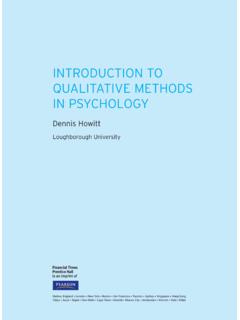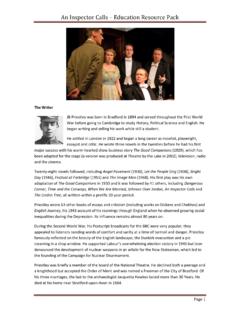Transcription of Gazing from home: Cultural tourism and art museums
1 Gazing FROM home : CULTURALTOURISM AND ART MUSEUMST heopisti Stylianou-LambertCyprus University of Technology, CyprusAbstract:This study reconstructs and expands well-established Cultural tourist typologieswhile offering an alternative model to help explain the subtle differences between differentcultural tourists in art museums . Keeping in mind that art museum visitors differ from visitorsof other kinds of museums and that museum visitation is not separate from everyday life, in-depth, semi-structured interviews in the participants home country were used to exploremuseum perceptions and memories of past museum experiences.
2 The main outcome ofthe study is the identification of eight different ways of perceiving the art museum whetherat home or a tourist destination. Five case studies are presented in order to demonstratethe need for more inclusive and flexible :typologies, art museum, cul-tural tourism , everyday life, museum perceptions. 2010 Elsevier Ltd. All rights , whenMcKercher (2004)surveyed Cultural attractions infive countries, he found that tourists tended to participate in the sametypes of activities regardless of destination. museums were found to bethe most popular attraction, usually followed by art galleries and monu-ments.
3 This is not surprising if we consider that museums help define theoverall tourism product of a destination by providing a sense of a partic-ular time and place that is often unavailable elsewhere (Graburn, 1983,1998; Tufts & Milne, 1999). Apart from providing a sense of hereness (Kirchenblatt-Gimblett, 1998), museums are part of a universal culturalsystem for the dissemination of knowledge and experience (Herreman,1998). AsKirchenblatt-Gimblett (1998)mentions, tourism needs des-tinations, and museums are premier attractions (p. 132).The growing contribution of Cultural institutions like museums tothe attractiveness of a destination, and therefore to its economy, hasurged researchers to turn their attention to the links between theeconomy and culture (Capstick, 1985).
4 As a result, tourism profession-als view museums as a part of the modern Cultural complex of aTheopisti Stylianou-Lambertis a lecturer at the Cyprus University of Technology [9 Diagorou Str, K. Lakatameia, 2334, Nicosia, Cyprus. earned her PhD in Museum Studies from the University of Leicester and her MA in ArtEducation/ Museum Education from the University of Texas at Austin. Her research interestsinclude museum and visitor studies with an emphasis on art museums , Cultural tourismstudies, and issues of Cultural of tourism Research,Vol. 38, No. 2, pp. 403 421, 20110160-7383/$ - see front matter 2010 Elsevier Ltd.]
5 All rights in Great that can attract tourists (MacCannell, 1999) while museumprofessionals view tourists as a distinct group with particular needs thatmust be , with a few exceptions, most tourism studies appear tobe fragmented. This is mainly due to the fact that they investigate spe-cific destinations or institutions and therefore no generalizations canbe made that can eventually help build broad and strong theoriesregarding Cultural tourism . Furthermore, there seems to be a lack ofmulti-disciplinary perspectives (Wall, 2010), which in some cases areessential to analyzing specific types of Cultural tourism .
6 For example, Cultural tourists might seek different experiences in an art museum,a history museum, an opera, or an outdoor festival. Finally, many stud-ies separate home behavior from tourism behavior, even though thisseparation seems more artificial than good news is that post-modern theories have ignited new trendsin the conceptualization of the tourist experience (Uriely, 2005). To be-gin with, there is an increased interest in the performances, subjectiveexperiences, and meanings tourists make (B renholdt, Haldrup,Larsen, & Urry, 2007; Edensor, 2000; Prentice, Witt, & Hamer, 1998;Richards & Wilson, 2006).
7 Significantly, the emergence of tourist typol-ogies is considered a step towards the recognition of the diverse andplural character of tourist experiences (Cohen, 1979a; Uriely, 2005).Additionally, while tourism has traditionally been considered as an es-cape from everyday life or a form of getting away from it all (Graburn,1989), increasing evidence supports the view that tourism can be viewedinstead as an extension of everyday life (Kim & Jamal, 2007).Following these trends in theorizing tourists experiences, this study(a) does not separate everyday life from tourism experiences; (b) fo-cuses on a specific form of Cultural tourism that of art museums ;(c) acknowledges the subjective nature of experience without ignoringthe factors that help shape it; (d) concerns itself with the developmentof a holistic and flexible Cultural tourist typology for art museumswhich can account for a number of tourist experiences; and finally,(e) complements and expands rather than contradicts previous typol-ogies.
8 The two main purposes of this paper are to introduce an alter-native Cultural tourist typology for art museums and to argue thatexploratory research which explores emerging narratives and is con-ducted in the participants home environment can be extremely valu-able. Such methodological alternatives can potentially expose differentaspects of the same intellectual TOURISTS AND MUSEUM PERCEPTUAL FILTERSIt still seems that the tourism literature has not yet settled on a singledefinition for the term Cultural tourism (Dolnicar, 2002; Hughes,2002).Silberberg (1995)offers a broad definition by defining culturaltourism as: visits by persons from outside the host community moti-vated wholly or in part by interest in the historical, artistic, scientificor lifestyle/heritage offerings of a community, region or institution 404T.
9 Stylianou-Lambert / Annals of tourism Research 38 (2011) 403 421(p. 361). According to this definition, Cultural attractions can be muse-ums, galleries, festivals, architecture, heritage sites, artistic perfor-mances, as well as attractions related to food, dress, language, andreligion. Nevertheless, most often a slightly narrower definition is ap-plied. Cultural tourism is usually related to trips that include visits tosuch places as museums , art galleries, historical and archaeologicalsites, festivals, architecture, artistic performances, and heritage sites(Hughes, 1996; Stebbins, 1996). For the purposes of this paper, a cul-tural tourist is defined as any individual who visits Cultural institutionsor places such as museums , archeological and heritage sites, operas,theatres, festivals or architecture while away from home .
10 A visitor is defined as any individual who visits museums or galleries whetherat home or at a Tourist Typologies and Art MuseumsFor a long time Cultural tourists were treated as an undifferentiatedgroup of people. Recent tourist literature recognizes that Cultural tour-ists are not a homogenous mass but a heterogeneous market with dif-ferent characteristics and needs (Hughes, 2002). Furthermore, it isnow understood that visits to Cultural attractions are usually a second-ary activity and not the main motivation for visiting a destination(McKercher, 2004). As soon as it was recognized that the culturaltourist did not exist (Dolnicar, 2002), researchers started identifyingdifferent types of Cultural though it is not the purpose of this paper to provide an exhaus-tive overview of the studies dealing with Cultural tourist typologies, it isnecessary to mention the ones that influenced this study the most.

